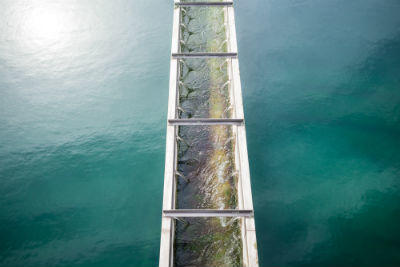For several years now, heat recovery systems from wastewater and hydroelectric microturbines installed in drinking water networks have been used to enhance the value of the energy they contain – and that is too often lost – in our pipes.
Hydropower, the third source of electricity production and main source of renewable energy in France, is known mainly for its dams and major plants. Underground waste water or drinking water networks are less visible, but also represent a local source of renewable energy that is able to heat or cool infrastructures, or more simply feed into the electricity network by increasing the share of clean energy. For several years now, various projects have focused on developing the value of water flow and temperature, a source of energy.
Using waste water to provide heating
With a temperature ranging between 10° and 15° in winter, and 15° and 25° in summer, urban waste water networks or water from purification stations are a local source of heat or cooling. During warm weather, they are cooler than ambient temperatures and in cold weather, they are warmer. The principle is simple but requires a certain investment: “Part of the output must be channelled towards a heat exchanger (which allows heat to be transferred between two fluids through a partition without mixing them). A reversible heat pump captures the calories from the network and channels them to a heating or cooling system,” explains Romuald Le Guilly, a Veolia thermal engineer, working on a number of projects including Energido, a system that allows energy to be recovered from networks of waste water.
At the Marseille Swimmers’ Circle, for example, these networks maintain the pools’ temperature at 27 degrees throughout the year. The result is a gas bill reduced by 35% and 230 fewer tonnes of CO2 emissions per year. The system is also used in the swimming centres in Arras, Aix-les-Bains and Saint-Laurent-du-Var, and will soon be in service at Aulnay-sous-Bois. “The system already powers the heating and cooling network of housing in the eco-neighbourhoods of Roquebrune-Cap-Martin and Saint Chamond and heats the purification station digesters or produces hot water for domestic use, with an average annual production for each installation of between 500 and 4,000 MWh, the engineer adds.
“Waste water is already fed into the heating and cooling network of housing in eco-neighbourhoods”.
The solution has numerous applications but also presents certain constraints: “One of the solution’s requirements is access to a sufficient flow, some 30 cubic metres an hour,” he explains. “The distance between the waste water catchment and the heat receptor must not be too big”. This technology has been used mainly in medium-sized towns, but could benefit larger cities in the years to come,” he adds, referring to recent studies about Paris. A “plug and play” solution requiring very little intervention by users, is also being considered for industrial and service industry clients (hotels, shopping centres, etc.).
Microturbines in drinking water pipes

In 2010, Nice became the first city in France to equip its drinking water network with hydropower microturbines. In this case, it is not the calories in the water that are captured, but its kinetic energy, transformed into mechanical, then electric energy. “It’s the same principle as in hydroelectric dams – the water sets the turbine linked to an alternator in motion – except that this is done directly in the water pipes, on a smaller scale,” says Paulo Fernandes, who is in charge of performance at Veolia’s water-treatment technologies “The microturbines use water’s potential energy,” he explains. “This energy is proportional to the difference in heightand volume of the water involved. This is applied in the case of Nice, where there are large heightand volume differentials.”
A similar system was installed at Barcelonnette in 2013, and takes advantage of the different levels of sources of drinking water based at 2,000 metres and flowing to a reservoir 600 metres lower. This avoids the emission of 494 tonnes of CO2 every year, and produces enough annual electricity for the lighting and domestic use of 970 inhabitants.
In the future, this principle could well be used more to meet our everyday requirements, including our toilets according to South Korean researchers. By converting water’s mechanical energy into electricity, they have shown that a single drop of water is sufficient to briefly light a LED bulb. They hope that this ingenious solution could be extended to sinks, but also to roofs and windows to recover the energy from rainwater. Enhancing the value of the energy of moving water will no doubt soon be par for the course.
A drop of water is sufficient to briefly light a LED bulb.
Enhancing the value of the energy of moving water will no doubt soon be par for the course.

In partnership with Usbek & Rica,the media that explores the future.


